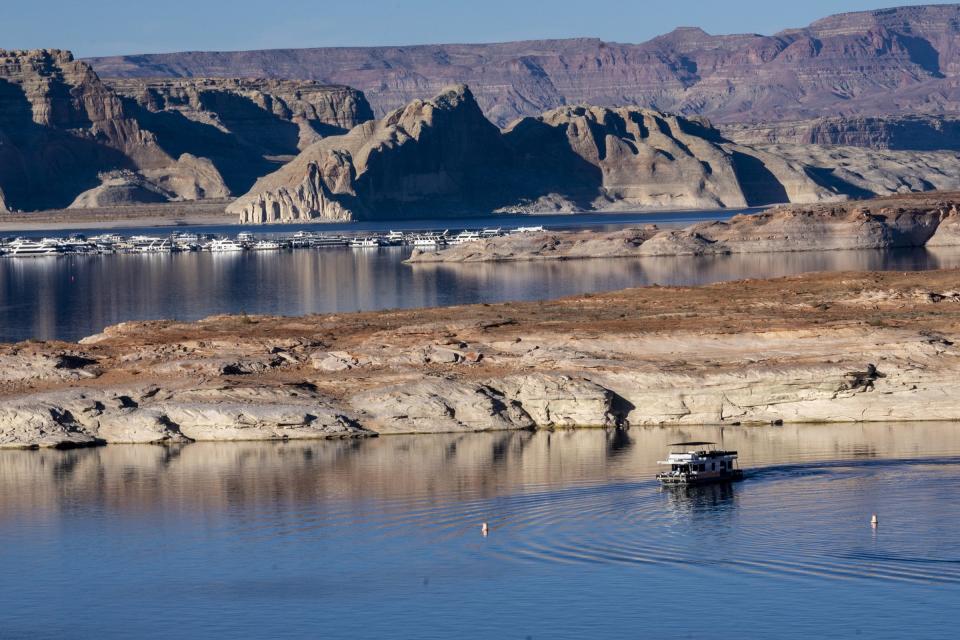Colorado River forecast improves with early snow, but the outlook could still change

Early winter rain and snow across the interior West have improved the outlook for springtime flows on the Colorado and other rivers that supply the Southwest.
The Colorado River Basin Forecast Center on Friday released a forecast projecting that the river and its tributaries would pour about 99% of normal flow into Lake Powell by April, though that’s based on a new and not-so-improved normal afflicted by climate change.
The center, an agency of the National Weather Service, last summer updated the watershed’s long-term baseline to reflect the last 30 years of flows, which were deeply reduced by drought.
Compared to the old normal, the forecast is for 88% of average, or about 6.3 million acre-feet.
With the bulk of snow season yet to come, the outlook could still change profoundly. Last year’s snowpack looked close to normal but delivered paltry snowmelt to rivers and reservoirs because parched soils soaked up more than is typical in spring.
This year, soil moisture has taken a feast-or-famine route to its current condition: better than last year, which was nearly a record low, but still below average across much of the region. A wet monsoon season moistened the soil before a dry November reversed some of the gains, forecast center hydrologist Cody Moser said.
“Things really dried out,” Moser said.
Then the final three weeks of December stacked snow in the mountains and sent more water into the ground.
Lake Powell is a critical storage reservoir from which government dam managers release the water needed to replenish what’s taken out of Lake Mead by downstream users in Arizona, Nevada, California and Mexico. In combination, the two massive reservoirs have dropped from near capacity in 2000 to just over a third full, prompting farm shortages in central Arizona this year.
To prevent worsening shortages, Arizona recently committed $100 million to conservation measures that will keep more water in the system over the next two years.
Within Arizona, the Salt and Verde watersheds, which supply Salt River Project customers in the Phoenix area, are cumulatively 10% above normal precipitation since the water year began on Oct. 1, said Bruce Hallin, SRP’s director of water supply.
That, in addition to the wet soils that the monsoon left in the Mogollon Rim country, are providing some respite in a winter that still is expected to be a dry one in the Southwest. The Pacific Ocean’s surface temperatures have put the region into a La Niña cycle, which generally means dry weather in Arizona.
“All forecasts are pointing to lower than normal precipitation in the January-February timeframe,” Hallin said, “but the watershed is so wet.”
The wet soils have allowed more of what has fallen over fall and winter to actually reach SRP’s reservoirs, so that December runoff into them was 18% higher than usual.
Still, those reservoirs are just 70% full, which is lower than where they stood early last winter.
La Niña-influenced winters tend to be more fickle farther north in the Rockies, where most of the Colorado River's water comes from, leaving room for hope that the early season gains may portend a wet season.
Brandon Loomis covers environmental and climate issues for The Arizona Republic and azcentral.com. Reach him at brandon.loomis@arizonarepublic.com.
Environmental coverage on azcentral.com and in The Arizona Republic is supported by a grant from the Nina Mason Pulliam Charitable Trust. Follow The Republic environmental reporting team at environment.azcentral.com and @azcenvironment on Facebook, Twitter and Instagram.
This article originally appeared on Arizona Republic: The Colorado River could see normal flows into Lake Powell in spring.

 money
money 